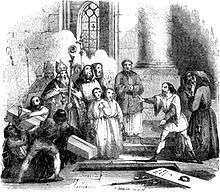Clameur de haro

The Clameur de Haro (French pronunciation: [klamœʁ də aʁo]) is an ancient legal injunction of restraint employed by a person who believes he is being wronged by another at that moment. It survives as a fully enforceable law to this day in the legal systems of Jersey and Guernsey, and is used, albeit infrequently, for matters affecting land.
History
Based in Norman law, it is often thought to be a plea for justice to Rollo, the 10th century founder of the Duchy of Normandy, interpreted as a contraction of "Ha-Rollo". 'Harrow' meaning 'give chase' was commonly used in medieval England and France as a cry to others to drop what they were doing and assist in the apprehension of a miscreant.[2] It survives in English hunting parlance as 'Halloo' and possibly in the word 'harrier' as a name for a runner.
The Clameur was perhaps most famously used by a landowner named Asselin FitzArthur to object to the burial of William the Conqueror.[3]
Procedure
The procedure is performed on one's knees before at least two witnesses, in the presence of the wrong-doer, and in the location of the offence. The "Criant" with his hand in the air must call out —
Haro! Haro! Haro! A l'aide, mon Prince, on me fait tort.
(Hear me! Hear me! Hear me! Come to my aid, my Prince, for someone does me wrong.)
Following this, the Criant must recite the Lord's Prayer in French (although not necessarily including the doxology).
Notre Père qui est aux cieux. Ton nom soit sanctifié. Ton règne vienne. Ta volonté soit faite sur la terre comme au ciel. Donne-nous aujourd'hui notre pain quotidien. Et nous pardonne nos offenses, comme nous pardonnons à ceux qui nous ont offensés. Et ne nous induis point en tentation, mais délivre-nous du mal.
On hearing this, the alleged wrong-doer must cease his challenged activities until the matter is adjudicated in court. Failure to stop will lead to the imposition of a fine, whether they were in the right or not. If the Criant is found to have called Haro without a valid reason, he in turn must pay a penalty.
The Clameur in Guernsey requires that a Grace be said after the Lord's Prayer:
La Grâce de Notre Seigneur Jésus Christ,
la dilection de Dieu et la sanctification de Saint Esprit
soit avec nous tous éternellement. Amen.[4]
Furthermore, the grievance must be put in writing and lodged at the Greffier within 24 hours.[5]
Limitations
Clameur de Haro can be overruled. For instance, in 1778 the States of Guernsey decided to erect 15 loophole towers at various points on the coast to impede any French incursion on the island. Although most of the towers were built on the Commons, or on public land above the high-water mark, three towers were to be built on private land. The States were of the opinion that the project was of such importance that if necessary they would exercise eminent domain, "...notwithstanding any Clameur de Haro or any opposition whatsoever...".[5]
See also
Notes
- ↑ Turner Account of a Tour in Normandy p. 200
- ↑ http://www.clameur.gg/history.html
- ↑ "Legal Quote of the Week: Clameur de Haro". Business Law Basics.
- ↑ Appendix, Laws of Guernsey
- 1 2 Grimsley (1988), pp. 19-21.
References
- Dawes, Gordon, Laws of Guernsey, (Hart Publishing, 2003). ISBN 1-84113-396-5
- Grimsley, E.J. (1988) The historical development of the Martello Tower in the Channel Islands. (Sarnian Publications). ISBN 978-0951386804
- Holden, Richard, Jersey Law Course: Civil Procedure (Institute of Law, Jersey, 2011), chapter 23. ISBN 978-1-908716-01-9
- Turner, Dawson (1820). Account of a Tour in Normandy. 2. London: John and Arthur Arch.
External links
- Jersey Legal Information Board
- Jersey Citizens Advice Bureau
- Criants, Clamerists and the Clameur de Haro in the Channel Islands
 Chisholm, Hugh, ed. (1911). "Haro, Clameur de". Encyclopædia Britannica. 6 (11th ed.). Cambridge University Press. p. 11.
Chisholm, Hugh, ed. (1911). "Haro, Clameur de". Encyclopædia Britannica. 6 (11th ed.). Cambridge University Press. p. 11.